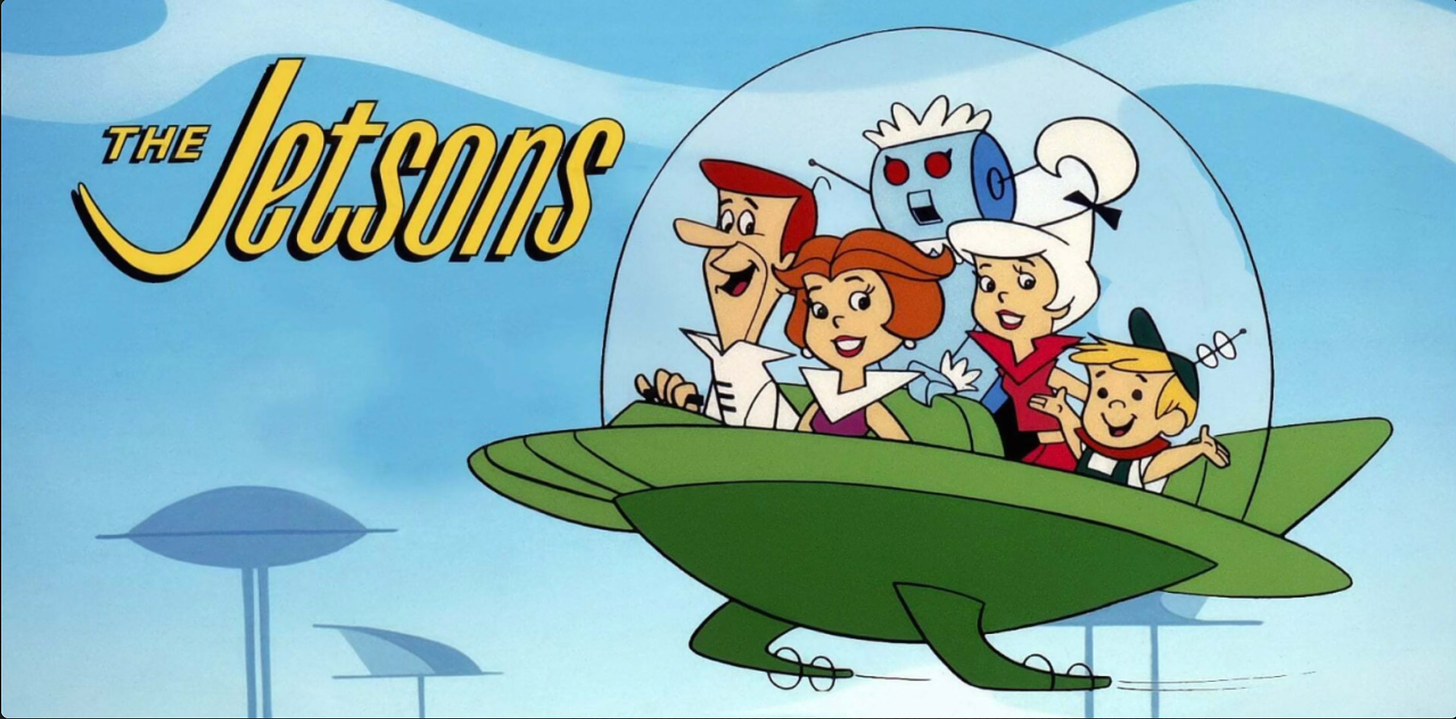Where Did The Jetsons Hide Their Drug Addicts?
In the News: Tesla Delays Robo-Taxis | Sam Altman on Universal Basic Income | The Supreme Court on Homelessness | Waymo Expands in San Francisco | Apple Signs onto Biden AI Pledge
A Tale of Two Futures: Tesla and Waymo Crash Into Reality in San Francisco
The future arrived silently, gliding to a stop at the curb outside my San Francisco hotel. As I settled into the backseat of the Waymo driverless taxi, I couldn't shake the feeling that I was stepping into an episode of The Jetsons. No driver, no fuss – just an AI chauffeur ready to whisk me across town to the de Young Museum.
For the first ten minutes, it was nothing short of miraculous. The autonomous vehicle navigated the city's infamous hills and congestion with precision. At one point, it even reversed out of a tricky situation, honking its horn, and slipping around a double-parked delivery van. Artificial intelligence in action, smooth as silk.
But then, like so many technological marvels, it quickly became... ordinary. Waymo had successfully approximated the perfect taxi ride, minus the human touch. No music, no smells, no conversation. The novelty wore off, and my gaze drifted to the streets outside.
That's when I saw them. San Francisco's homeless population, out in full force. People who looked desperate, destitute, possibly addicted. Their lives a stark contrast to the utopian tech cocoon I was riding in.
It struck me then: What did The Jetsons do with their drug addicts?
For those unfamiliar, The Jetsons was a 1960s animated sitcom about a futuristic family living in the sky, surrounded by flying cars and robot maids. But like all utopias, the show glossed over any darker realities.
This jarring juxtaposition – cutting-edge AI and human suffering side by side – set the backdrop for my week at the AI Engineer's World's Fair. And it wasn't just on the streets. Even as I rode in this realized version of our autonomous future, news broke of yet another delay in Elon Musk's grand Tesla plans.
Elon's Elastic Time
Martin Luther King Jr.’s staff—when he had to show up late to some event—used to joke about their boss’ sometimes cheerful disregard for the lateness of the hour. King himself said once that he forgot which time zone he was in - "Eastern Standard Time, Central Standard Time, or Colored People's Time.”
Elon Musk recently announced another delay in Tesla's ambitious robo-taxi program, where Tesla cars will autonomously take to the streets to earn income for their owners. The unveiling now slips from August to October. It's a familiar story for those who follow Musk's optimistic project announcements, which are often just a wee bit late. Clearly, brother Elon, our wealthiest African-American (he was born in South Africa), operates on his own version of Colored People’s Time.
Unlike King, whose occasional tardiness never diminished the urgency of his message, I fear that our elastic application of technological progress might be leaving too many people behind.
A Tale of Two Cities
As I stepped out of the Waymo and into the AI conference at the Marriott, the contrast became even more pronounced. Inside, a sea of developers and entrepreneurs – myself included – poked at our devices, connecting databases to other databases, handsomely paid to widen the gap between the haves and have-nots.
Our lives – my life – are objectively a utopia compared to those on the streets. But like all utopias, there is a terrible cost that someone must pay. It's a pattern we've seen before, in fiction and in history. The Jetsons' sky-high utopia conveniently ignored whatever was happening on the ground below. Today's tech hubs, with their mix of promises, realized and delayed, risk doing the same.
Reality on the Ground
The timing of my visit added another layer of complexity to this tale of two cities. Just days before, the U.S. Supreme Court had issued a ruling allowing cities to re-impose restrictions on where homeless individuals can sleep. In response, California Governor Gavin Newsom issued an executive order to begin dismantling homeless encampments across the state.
As I shuttled between my Waymo rides and the tech conference, these policy decisions cast a long shadow. The juxtaposition of extreme wealth and innovation against profound poverty and human misery became impossible to ignore. It felt as if the price of my easy, no-hassle ride was somehow tied to those people's lives on the street.
Bridging the Divide
So, what do we do? As we push the boundaries of AI and technology, we must remember the human element. Let’s build systems that help everyone, not just the fortunate few. Here are some approaches worth exploring:
Explore Universal Basic Income (UBI) Programs
A recent three-year study by Sam Altman’s OpenResearch found that providing $1,000 monthly to low-income participants led to increased job searching, more selective job choices, and greater interest in entrepreneurship. While UBI recipients worked slightly fewer hours, they reported increased spending on essentials and improved financial stability. Implementing UBI could provide a safety net for those displaced by automation and AI.
Invest in Education and Job Training
Participants in the UBI study who received additional income were more likely to pursue education and job training. Tech companies could partner with educational institutions to create tailored programs for the AI economy. Google’s “Grow with Google” and Amazon’s AI Ready initiative are examples of such efforts, aiming to democratize access to AI education and training.
Support Tech-Driven Solutions to Social Issues
Use AI and technology to address homelessness and poverty directly. The Los Angeles Homeless Services Authority uses AI to match homeless individuals with appropriate housing and services. The startup Miracle Messages helps reunite homeless individuals with their families using social media and AI. The White House’s ALL INside initiative aims to address unsheltered homelessness across the country through federal-local partnerships.
Advocate for Inclusive Economic Policies
While additional income improved financial stability, it didn’t address all systemic issues. Advocate for policies that ensure the benefits of technological progress are more evenly distributed. This could include progressive taxation on AI-driven profits to fund social programs or policies requiring companies developing automation technologies to contribute to retraining funds for displaced workers.
Prioritize Accessible Design
Build accessibility and inclusivity into products from the ground up. Microsoft’s AI for Accessibility program and Google’s Project Euphonia are examples of efforts to make technology more inclusive. UNESCO’s Information for All Programme advocates for accessibility in emerging digital technologies to create inclusive knowledge societies.
Promote Mental Health and Well-being
The UBI study found initial improvements in mental health among recipients, suggesting the need for more comprehensive approaches. Tech companies could invest in AI-driven mental health apps or virtual therapy platforms to make mental health support more accessible and affordable.
Foster Community Engagement
Use technology to strengthen community bonds and promote civic engagement. Apps like Nextdoor connect neighbors and facilitate local community action. Similar platforms could connect people across socioeconomic lines, fostering understanding and collective action on local issues.
Encourage Comprehensive Transparent Impact Reporting
Tech giants, including Apple, Google, Meta, and Microsoft, have signed an agreement with the Biden administration committing to voluntary AI safeguards. We should encourage these companies to expand their voluntary reporting to include broader societal impacts of AI, such as employment shifts, economic opportunity, community well-being, and environmental considerations.
A Call to Action
The future doesn't have to be a tale of two cities - one in the clouds and one on the ground. With conscious effort, compassion, and innovative thinking, we can create a future that lifts everyone up. The Jetsons may have conveniently ignored what was happening below their sky-high utopia, but we have the opportunity - and the responsibility - to do better.
As we marvel at the Teslas and Waymos whirring through our streets, let's ensure we're building a world where everyone has the opportunity to rise. There is no need for an AI-powered world to leave anyone behind.
So, I challenge you: Pick one of these approaches. Learn more about it. Get involved. Whether it's volunteering your tech skills for a social good project, or advocating for more inclusive tech policies, your actions can help bridge the divide.
Remember, the next time you see a driverless car glide by, ask yourself: In our vision of the future, where are we hiding our most vulnerable? And more importantly, how can we bring them along for the ride?
Related Reading
Driverless Cars
Tesla Delays Robotaxi Event in Blow to Musk’s Autonomy Drive
Waymo's robotaxis are better than some San Francisco drivers
San Franciscans Aren’t Just Angry at Driverless Robotaxis, They’re Angry at Being Ignored
Homelessness and the Courts
How will Supreme Court ruling on homeless camps affect California? Cities across state weigh in
Newsom Orders California Officials to Remove Homeless Encampments
Implementing a Data-Driven Approach to Tackling Homelessness
Preparing for AI Disruptions
A Sam Altman-Backed Group Studied Universal Basic Income For 3 Years. Here’s What They Found.
AI companies promised to self-regulate one year ago. What’s changed?







